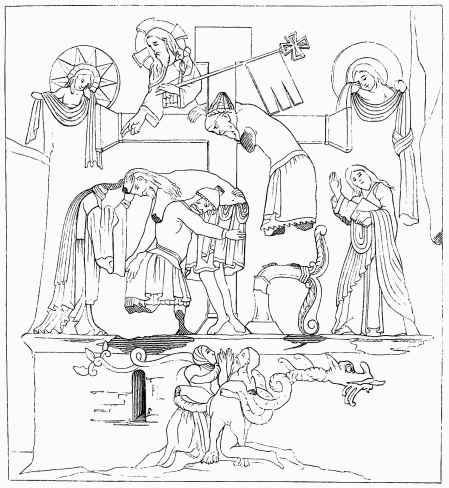Alien Nummo in the Roman Catacombs
and on the Externsteine Relief
Updated October 1, 2023
 Alien Nummo on the Externsteine ReliefShannon Dorey, The Nummo, 2019 edition, p.186 |
A serpent-like figure, shown at the bottom of this 1862 drawing of the Externsteine Relief, is associated with the green, alien Nummo. The figure has whiskers, horns and a long serpent-like tail, which is also seen in the Roman catacombs of San Callisto, shown below, and dated to the second century. The alien Nummo were green aquatic beings, who were associated with serpents because when they moved on land, they looked like serpents.Shannon Dorey, The Nummo, 2019 edition, p.186
 Green Nummo in San Callisto CatacombsShannon Dorey, The Nummo, 2019 p. 5 |
The Externsteine is identified as a sacred site of the pagan Saxons, and the place where the Irminsul idol once existed that was supposed to have been destroyed by Charlemagne in around 800. In the high medieval period it was used as a Christian chapel.Shannon Dorey, The Nummo, 2019 edition, p.186
These fish and serpent like beings have inconsistent Christian explanations because they are associated with the alien Nummo from the Dogon pagan religion, which my research reveals is much older than Christianity. The serpent figure in this depiction of the Externsteine Relief is supposedly depicting the Christian story of the Descent from the Cross.Shannon Dorey, The Nummo, 2019 edition, p. 186 The green fish and serpent-like figure from San Callisto and found on the Appian Way in Rome is supposed to be depicting the Christian story of Jonah and the Whale.Shannon Dorey, The Nummo, 2019 edition, pp. 4-5
Both the relief of the Externsteine and the painting from the San Callisto catacombs are depicting the regeneration of Lébé as it was known to the Dogon people of Mali, Africa. Lébé was an androgynous figure, who was considered the mother of present day humans.Shannon Dorey, The Nummo, 2019 edition, p. 186
Lébé was symbolized by the lion in the Dogon religion, and lion's feet appear on the Externsteine Relief. The arms between the two people are lions' paws, which are giving the woman a high five gesture.Shannon Dorey, The Nummo, 2019 edition, p.187 The tail of the serpent winds around the male Christ figure and the woman. This is likely indicating the androgynous or twin aspect of Lébé. Lébé as the lion, is being associated with Christ, whose head is in the place where the lion's head should be.Shannon Dorey, The Nummo, 2019 edition, p.187
To reveal that the pure DNA of the Master (Mistress) of Speech was used in the regeneration of Lébé, Lébé was mythically swallowed and then regurgitated by the Master (Mistress) of Speech. We see this mythical swallowing and regurgitation on the depiction from the early Christian catacombs of San Callisto, shown above.Shannon Dorey, The Master (Mistress) of Speech, 2018 edition, p. 142
In the Dogon religion, this event took place in Lébé's grave, which is what this lower area of the Externsteine relief suggests.Shannon Dorey, The Nummo, 2019 edition, p.186 The catacombs are also underground burial chambers existing beneath Rome.
Although Lébé was born androgynous, five generations after Lébé's birth, humans became single-sexed beings. The regeneration of Lébé was an important aspect of the Dogon religion because it was hoped that as a result of the genetic changes that humans would eventually find truth, androgyny and immortality.
The Externsteine is a sandstone rock formation in the Teutoburg Forest in the Lippe district of the German state of North Rhine-Westphalia. It consists of a tor and several tall narrow columns of rocks surrounded by wooded hills.Shannon Dorey, The Nummo, 2019 edition, p.186
Refer to this article for more information on early Christianity. Alien Fish-tailed Nummo Represented Salvation in Early Christianity and Judaism
You can also purchase my books or PDFs at Purchase Books.